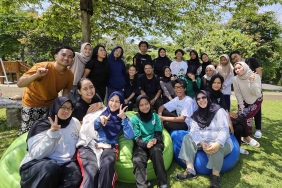TRAINING OF TRAINERS (TOT) FOR ASSISTED SCHOOL TEACHERS IN LAMPUNG
By: Hijrah Nasir
In the Living Planet Report 2016 conducted by WWF International, in 2012 it took the biological capacity equivalent of 1.6 planet earths to provide the natural resources and environmental services consumed by humans in that year. This is an alarm that the planet we inhabit today has limited natural resources that must be maintained. To maintain this sustainability, the role of education is very important by providing an understanding that there is only one planet earth with limited natural resources. With education, children are embedded with knowledge that allows them to discover new things that have never existed before so that they can advance themselves and can be utilized wisely. In addition, education can also instill positive things early on in students.
WWF-Indonesia has conducted Education for Sustainable Development (ESD) trainings in Kalimantan, Sumatra, Sulawesi, Java, and Papua and has provided assistance to 45 schools. The assisted schools are expected to have an impact on the surrounding schools. In Lampung Province, there are 3 assisted schools, namely SDN 1 Datarajan, SDN 1 Sukamaju, and SDN 2 Karangrejo. For ESD dissemination, it is hoped that these three schools can become pioneers of ESD dissemination. For this reason, capacity building is needed for these teachers in the form of Training of Trainers (ToT).
The ToT was held from October 24 to 27, 2017 at the Datarajan Village Hall, Ulubelu Sub-district, Tanggamus, Lampung, which was attended by teachers of WWF-Indonesia assisted schools, namely SDN 1 Datarajan, SDN 1 Sukamaju, SDN 2 Karangrejo and the impact school, SDN 1 Karangrejo. This ToT was facilitated by Rini Andriani and Novita from WWF Indonesia. The implementation of this ToT is expected to be able to provide teachers with an understanding of the basic principles of ESD, increase the capacity of teachers in implementing Education for Sustainable Development with a whole-school approach, build commitment to disseminate ESD, and improve the ability of teachers to develop training methods that will be carried out.
On the first day, the training was filled with materials on ecological footprints, ESD, and important themes in ESD. This material is given so that participants understand the concept of ecological footprint as the basis for sustainable development, provide an understanding of the concepts, principles, and history of the development of ESD, and to identify and map important local themes for the development of teaching materials.
In one of the sessions, participants were asked to observe a sealed clear glass jar filled with soil, animals, and plants and predict how long the plants, animals, water, fertilizer, and air would last in the jar, and the overall weight of the jar over a year. All groups answered that the plants and animals will survive as long as the jar is not open or damaged because there is an ecosystem inside where there is fertilizer, water, and oxygen. If the jar is open, it will not survive because there is no air cycle. Water will still be available because of the hydrological cycle. The fertilizer runs out but will dissolve in water, while the air remains because photosynthesis occurs because of the clear glass bottle that allows sunlight to enter.
In this process, there are animals that produce carbon dioxide and plants that produce oxygen so that there is interdependence. Meanwhile, the overall weight of the bottle will remain the same because there is a cycle where plants have a time to die, then some grow so that the weight of the bottle remains the same. This bottle media is a miniature earth that is tightly closed. If there is a leak from the lid of the jar, it is the same as the greenhouse gas that occurs on earth. A healthy earth is expected to be maintained from generation to generation.
The next day, the facilitator provided material on Teaching and Learning in ESD and ESD integration in the curriculum which aims to make participants understand the principles of learning and be able to apply various learning methods in ESD and be able to map local themes and content standards in KTSP or K-13 and prepare lesson plans both integrated into one subject and thematic, and be able to practice ESD teaching. Materials on a whole-school approach to ESD and materials on designing and implementing ESD training activities for educators were discussed on the third day of this ToT. The last day of the ToT was filled with the practice of the results of designing training, both in terms of materials and methods as well as evaluation and follow-up plans.
At the end of the session, participants wrote down their expectations and follow-up plans from this training. In general, participants expected further assistance on waste utilization, learning methods on alternative energy and the design of learning aids. The follow-up plan from this training is that each school will conduct socialization about ESD to other schools, arrange school gardens, reading parks, playgrounds, and process organic waste into fertilizer and inorganic materials into valuable materials.





